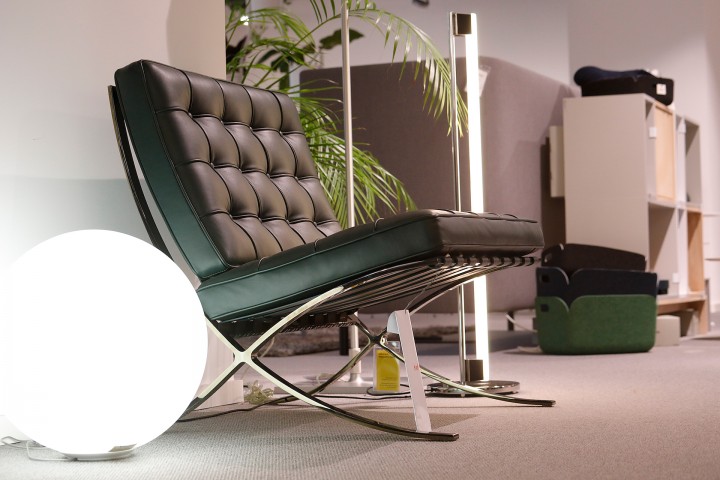The Knoll International Company
The leather expert Wilhelm Knoll (1839-1907) founded a leather store in Stuttgart in 1865. Knoll leather soon becomes a brand and Wilhelm Knoll is appointed "Royal Court Supplier". The Knoll dynasty is born and in 1906 it transforms into the Wilhelm Knoll leather seating furniture factory. Sons Willy (1878-1954) and Walter Knoll (1876-1971) take over the company and introduce the first club chair in Germany. While the first-born must initially be dismissed from the company, Walter Knoll follows in his father's footsteps. In 1912, series production of the Nestra models begins. The Prodomo armchairs also radiate more lightness than contemporary furniture, as the material aluminum is used. Zeppelins are equipped with the light aluminum armchairs. The first wide-body aircraft DoX was equipped with the light Prodomo aluminum armchairs while Wilhelm Knoll changes the traditional upholstery technique with the legally protected brand Antimott. During this period, Walter Gropius founded the Bauhaus in Weimar with new ideas of architecture and product design. Superfluous things like flourishes were yesterday. The Werkbund exhibition "Die Wohnung" in Stuttgart in 1927 also sets new standards for modern living worldwide. Knoll International is there.
On the road to modernity - The Weissenhofsiedlung (Werkbund housing estate)
The Weissenhofsiedlung (or Werkbundsiedlung) was built under the direction of architect Ludwig Mies van der Rohe and is considered an important architectural settlement. The name Weißenhof derives from the first settler, baker Georg Philipp Weiß, who used the fallow land for a farm in 1779. Like the Bauhaus, the Deutsche Werkbund e.V. (DWB), an association of artists, architects and entrepreneurs, is concerned with modern architecture and design. The DWB was founded in 1907 to secure a position for German products on the world market through good design. Functionality, material justice and a humane working environment were and are its basic quality criteria. Material justice means that every material shows its original appearance and properties; if wood is used, it is allowed to look like wood and should not be painted over - this is the maxim. This authenticity also characterizes Knoll's design. Walter Knoll was allowed to furnish five of Mies van der Rohe's new apartments in the Weißenhofsiedlung. In 1937 it becomes too crowded at the Stuttgart location and the growing Walter Knoll company moves some thirty kilometers south to Herrenberg. The Knoll Wassily armchair and the matching Knoll Laccio coffee table by Marcel Breuer from 1925 are considered the Bauhaus classics of all time.
In search of new markets
In 1938, Hans (1914-1955) goes to the USA to sell his father Walter's furniture. In America he also meets the architect and designer Eero Saarinen (1910-1961) and his future wife, the architect Florence Basset (1917-2019), who will have a great artistic influence on the products of the house. In 1943 Florence Basset joins Knoll's firm, followed by their marriage in 1946. The company is now called Knoll Associates. The Saarinen side table from 1955 to 1957 by Knoll International is considered a design classic. From 1939, no furniture is allowed to be produced, only so-called war-important articles. Bombardments also prevent this, so that the Knoll ventures can only resume in 1945.
Knoll International in the post-war period
Son Robert Knoll becomes a partner in 1946. In 1947 Walter Knoll and his son Hans promote a new way of life. The Vostra armchair showed courage for casual sitting for the first time; it was considered unconventional and became a symbol of the dawn of modernity. The armchair, which was also used to furnish a student dormitory in Hamburg in 1953, brought Walter Knoll international recognition once again. The furniture fair in Cologne in 1950 brought a breakthrough for Wilhelm Knoll's furniture. In 1953, the Knoll company acquired the manufacturing and sales rights for the iconic Barcelona Chair and matching Barcelona Stool, designed by architect and designer Ludwig Mies van der Rohe between 1929 and 1931. After the death of his father Willy, Dieter Knoll takes over the Wilhelm Knoll company. Dieter Knoll also expands into Austria. In 1964, Walter Knoll retires and his internationally renowned company is continued by Robert Knoll and his nephew, Dr. Walter Combe.
The wild 1970s and 1980s
In the 1970s, important contract furnishings followed, such as the furnishing of Berlin-Tegel Airport in 1975. The "Contract" division designed executive offices, conference rooms, foyers and lobbies. These include the chairs of metal artist Harry Bertoia, the Diamond Chair and the Knoll Bertoia chair, which were designed as early as the 1950s and are still considered modern classics today. In the 1980-ies Stephan Combe and Michael Knoll take over the management of Walter Knoll and from 1985 also continue the Wilhelm Knoll company under the name "Collection Wilhelm Knoll".
New start in the 1990s and after the turn of the millennium
Friendly takeover in the New Age: In 1993, the Walter Knoll company is taken over by Rolf Benz (*1933) and Rolf Benz AG & Co. KG took over. Benz was an upholsterer by trade and gained experience in his uncle's upholstery manufacturing business. In 2008, Rolf Benz received the Federal Cross of Merit for his commitment to Baden-Württemberg. His eldest son, Markus Benz (*1961), has been running the business ever since. His sister Barbara Benz also works for the company. A subsidiary in Australia, showrooms in major European cities and a new production hall in Mötzingen have quickly established themselves. In Herrenberg, work has been carried out since 2006 in a glass factory designed by architect Hansulrich Benz. Every piece of leather or fabric at Knoll International is inspected for natural characteristics before it is processed; Knoll's natural materials can tolerate a wrinkle as they age. The leather comes exclusively from European cattle and is tanned in an environmentally friendly manner in Europe. Covers are made of a special blend of handcrafted perfect functional and decorative stitching, which is another quality feature of Koll International. The edge reinforcement, which prevents the upholstery from sagging at the edge when sitting, is also considered special at Walter Knoll.
Knoll International in the pro office store
You can find numerous pieces of furniture from the traditional Knoll company in the pro office Shop, including the Knoll Saarinen side table, which Eero Saarinen designed between 1955 and 1957. Knoll produces this classic to this day as a side table, dining table or coffee table. Modern classics are also the wire chairs, the Knoll Diamond Chair and the Knoll Bertoia chair designed by metal artist Harry Bertoia in the 1950-ies. The famous Barcelona Chair is still handcrafted today based on the design by Ludwig Mies van der Rohe. The chrome frame is hand-polished, the upholstery is hand-sewn from a skin; each Barcelona chair and matching stool is unique. The Knoll Wassily armchair, design Marcel Breuer from 1925, is also high-gloss chrome-plated and finished with leather. The furniture bears the KnollStudio logo and the designer's signature in the frame, just like the matching Knoll Laccio 1 coffee table or its bigger brother, the Laccio 2 coffee table. The Knoll company stands for living spaces and furniture as an expression of personal identity.





